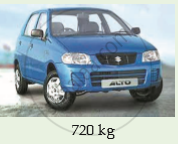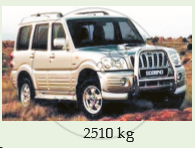Advertisements
Online Mock Tests
Chapters
![Lakhmir Singh solutions for Physics (Science) [English] Class 9 ICSE chapter 2 - Force and Laws of Motion Lakhmir Singh solutions for Physics (Science) [English] Class 9 ICSE chapter 2 - Force and Laws of Motion - Shaalaa.com](/images/physics-science-english-class-9-icse_6:911f810b387d4e338a7779e8e703c1e7.jpg)
Advertisements
Solutions for Chapter 2: Force and Laws of Motion
Below listed, you can find solutions for Chapter 2 of CBSE Lakhmir Singh for Physics (Science) [English] Class 9 ICSE.
Lakhmir Singh solutions for Physics (Science) [English] Class 9 ICSE 2 Force and Laws of Motion Very Short Answers 1 [Pages 55 - 57]
What name is given to the product of mass and velocity of a body ?
Name the physical quantity which is considered to be a measure of the quantity of motion of a body.
What is the SI unit of momentum ?
state whether momentum is scalar or vector.
What is the total momentum of the bullet and the gun before firing ?
Name the physical quantity whose unit is kg.m/s.
What will be the momentum of a body of mass ‘m’ which is moving with a velocity V ?
What is the usual name of the forces which cannot produce motion in a body but only change its shape ?
Name the unbalanced force which slows down a moving bicycle when we stop pedalling it.
State whether the following statement is true or false :
Unbalanced forces acting on a body change its shape.
When a ball is dropped from a height, its speed increases gradually. Name the force which causes this change in speed.
Name the property of bodies (or objects) to resist a change in their state of rest or of motion.
What is the other name of Newton’s first law of motion ?
The mass of object A is 6 kg whereas that of another object B is 34 kg. Which of the two objects, A or B, has more inertia ?
Name the scientist who gave the laws of motion.
State whether force is a scalar or a vector quantity?
With which physical quantity should the speed of a running bull be multiplied so as to obtain its momentum ?
Fill in the following blank with suitable word :
(a) ………………is a measure of the inertia of a body.
Fill in the following blank with suitable word:
When a running car stops suddenly, the passengers are jerked …………………..
Fill in the following blank with suitable word :
When a stationary car starts suddenly, the passengers are jerked …………………..
Fill in the following blank with suitable word :
Newton’s first law of motion is also called Galileo’s law of ………………………
Fill in the following blanks with suitable word :
If there were no unbalanced force of……………….. and no…………………. resistance, a moving bicycle would go on moving for ever.
Explain why, it is easier to stop a tennis ball than a cricket ball moving with the same speed.
Explain the meaning of the following equation : .
p = m x v
where symbols have their usual meanings.
Explain how, a karate player can break a pile of tiles with a single blow of his hand.
Calculate the momentum of a toy car of mass 200 g moving with a speed of 5 m/s.
What is the change in momentum of a car weighing 1500 kg when its speed increases from 36 km/h to 72 km/h uniformly ?
A body of mass 25 kg has a momentum of 125 kg.m/s. Calculate the velocity of the body.
Calculate the momentum of the following :
(a) an elephant of mass 2000 kg moving at 5 m/s
(b) a bullet of mass 0.02 kg moving at 400 m/s
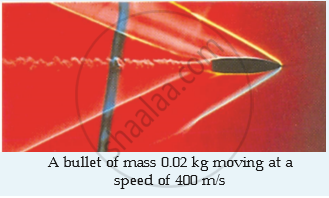
Which of the two, balanced forces or unbalanced forces, can change the shape of an object ? Give an example to illustrate your answer.
Describe the term ‘inertia’ with respect to motion.
State Newton’s first law of motion. Give two examples to illustrate Newton’s first law of motion.
On what factor does the inertia of a body depend ? Which has more inertia, a cricket ball or a rubber ball of the same size ?
Why do the passengers in a bus tend to fall backward when it starts suddenly ?
Explain why, a person travelling in a bus falls forward when the bus stops suddenly.
Give reason for the following :
When a hanging carpet is beaten with a stick, the dust particles start coming out of it.
When a tree is shaken, its fruits and leaves fall down . Why ?
Explain why, it is dangerous to jump out of a moving bus.
What is the momentum in kg.m/s of a 10 kg car travelling at (a) 5 m/s (b) 20 cm/s, and (c) 36 km/h ?
Define momentum of a body. On what factors does the momentum of a body depend ?
Calculate the change in momentum of a body weighing 5 kg when its velocity decreases from 20 m/s to 0.20 m/s.
Define the term ‘force’.
State the various effects of force.
Give one example where a force moves a stationary body.
Give one example where a force stops a moving body .
Give one example where a force changes the speed of a moving body.
Give one example where a force changes the direction of a moving body.
Give one example where a force changes the shape (and size) of a body.
What do you understand by the terms “balanced forces” and “unbalanced forces” ? Explain with examples.
What type of forces – balanced or unbalanced – act on a rubber ball when we press it between our hands ? What effect is produced in the ball ?
What happens to the passengers travelling in a bus when the bus takes a sharp turn ? Give reasons for your answer.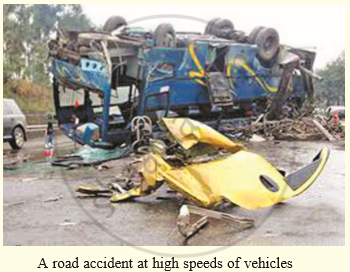

Why are road accidents at high speeds very much worse than road accidents at low speeds ?

When a toothpaste tube is squeezed, its shape changes. The force responsible for this is an example of :
balanced forces
centripetal forces
unbalanced forces
centrifugal forces
The inertia of an object tends to cause an object :
to increase its speed
to decrease its speed
to resist a change in its state of motion
to decelerate due to friction
When we talk of a force acting on a body, it usually means :
electrical force
balanced force
unbalanced force
nuclear force
A passenger in a moving train tosses a coin which falls behind him. This shows that the motion of train is :
accelerated
uniform
retarded
along circular track
'When a hanging carpet is beaten with a stick, the dust particles start coming out of it'. This phenomenon can be best explained by making use of :
Newton's third law of motion
Newton's law of gravitation
Newton's first law of motion
Newton's second law of motion
A water tanker filled up to `2/3` of its tank with water is running at a uniform speed. When the brakes are suddenly applied, the water in its tank would
move backward
move forward
rise upwards
remain unaffected
If we release a magnet held in our hand, it falls to the ground. The force which makes the magnet fall down is an example of :
balanced force
unbalanced force
magnetic force
muscular force
The inertia of a moving object depends on :
momentum of the object
speed of the object
mass of the object
shape of the object
When a rubber balloon held between the hands is pressed, its shape changes. This happens because :
balanced forces act on the balloon
unbalanced forces act on the balloon
frictional forces act on the balloon
gravitational forces act o the balloon
Which of the following effect cannot be produced by an unbalanced force acting on a body?
change in speed of the body
change in shape of the body
change in direction of motion of body
change in state of rest of the body
A plastic ball and a clay ball of equal masses, travelling in the same direction with equal speeds, strike against a vertical wall. From which ball does the wall receive a greater amount of momentum ?
A moving bicycle comes to rest after sometime if we stop pedalling it. But Newton’s first law of motion says that a moving body should continue to move for ever, unless some external force acts on it. How do you explain the bicycle case ?
A man throws a ball weighing 500 g vertically upwards with a speed of 10 m/s.
- What will be its initial momentum ?
- What would be its momentum at the highest point of its flight ?
A car is moving on a level road. If the driver turns off the engine of the car, the car’s speed decreases gradually and ultimately it comes to a stop. A student says that two forces act on the car which bring it to a stop. What could these forces be ? Which of these two forces contributes more to slow down and stop the car ?
There are two types of forces X and Y. The forces belonging to type X can produce motion in a stationary object but cannot change the shape of the object. On the other hand, forces belonging to type Y cannot produce motion in a stationary object but can change the object. What is the general name of the forces as (a) X, and (b) Y?
Lakhmir Singh solutions for Physics (Science) [English] Class 9 ICSE 2 Force and Laws of Motion Very Short Answers 2 [Pages 74 - 77]
Which physical quantity corresponds to the rate of change of momentum ?
State the relation between the momentum of a body and the force acting on it.
What is the unit of force ?
Define one newton force.
What is the relationship between force and acceleration ?
If the mass of a body and the force acting on it are both doubled, what happens to the acceleration ?
Name the physical quantity whose unit is ‘newton’.
Which physical principle is involved in the working of a jet aeroplane ?
Name the principle on which a rocket works.
Is the following statement true or false :
A rocket can propel itself in a vacuum.
What is the force which produces an acceleration of 1 m /s2 in a body of mass 1 kg ?
Find the acceleration produced by a force of 5 N acting on a mass of 10 kg.
A girl weighing 25 kg stands on the tloor. She exerts a downward force of 250 N on the floor. What force does the floor exert on her ?
Name the physical quantity which makes it easier to accelerate a small car than a large car.
Fill in the following blanka with suitable words :
To every action, there is an _____________ and _____________ reaction.
Fill in the following blanks with suitable words :
Momentum is a _____________ quantity. Its unit is _____________.
Fill in the following blanks with suitable words :
Newton’s second law of motion can be written as Force = mass × _____________ or Force = _____________ of change of _____________.
Fill in the following blanks with suitable words :
Forces in a Newton’s third law pair have equal _____________ but act in opposite _____________.
Fill in the following blanks with suitable words :
In collisions and explosions, the total _____________ remains constant, provided that no external _____________ acts.
Explain the meaning of the following equation :
F = m x a
where symbols have their usual meanings
To take the boat away from the bank of a river, the boatman pushes the bank with an oar. Why ?
Why does a gunman get a jerk on firing a bullet ?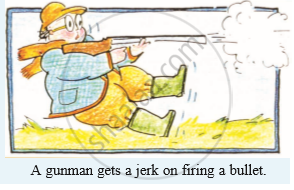
If action is always equal to reaction, explain why a cart pulled by a horse can be moved.
Explain how a rocket works.
Do action and reaction act on the same body or different bodies ? How are they related in magnitude and direction ? Are they simultaneous or not ?
If a man jumps out from a boat, the boat moves backwards. Why ?
Why is it difficult to walk on a slippery road ?
Explain why, a runner presses the ground with his feet before he starts his run.
A 60 g bullet fired from a 5 kg gun leaves with a speed of 500 m/s. Find the speed (velocity) with which the gun recoils (jerks backwards).
A 10 g bullet travelling at 200 m/s strikes and remains embedded in a 2 kg target which is originally at rest but free to move. At what speed does the target move off ?
A body of mass 2 kg is at rest. What should be the magnitude of force which will make the body move with a speed of 30 m/s at the end of 1 s ?
A body of mass 5 kg is moving with a velocity of 10 m/s. A force is applied to it so that in 25 seconds, it attains a velocity of 35 m/s. Calculate the value of the force applied.
A car of mass 2400 kg moving with a velocity of 20 m s-1 is stopped in 10 seconds on applying brakes. Calculate the retardation and the retarding force.
For how long should a force of 100 N act on a body of 20 kg so that it acquires a velocity of 100 m/s ?
How long will it take a force of 10 N to stop a mass of 2.5 kg which is moving at 20 m/s ?
The velocity of a body of mass 10 kg increases from 4 m/s to 8 m/s when a force acts on it for 2 s.
(a) What is the momentum before the force acts ?
(b) What is the momentum after the force acts ?
(c) What is the gain in momentum per second ?
(d) What is the value of the force ?
A gun of mass 3 kg fires a bullet of mass 30 g. The bullet takes 0.003 s to move through the barrel of the gun and acquires a velocity of 100 m/s. Calculate:
- the velocity with which the gin recoils.
- the force exerted on gunman due to recoil of the gun
Draw a diagram to show how a rocket engine provides a force to move the rocket upwards. Label the diagram appropriately.
Name the law involved in the following situation :
the sum of products of masses and velocities of two moving bodies before and after their collision remains the same.
Name the law involved in the following situation:
a body of mass 5 kg can be accelerated more easily by a force than another body of mass 50 kg under similar conditions.
Name the law involved in the following situation :
when person A standing on roller skates pushes another person B (also standing on roller skates) and makes him move to the right side, then the person A himself gets moved to the left side by an equal distance.
Name the law involved in the following situation :
if there were no friction and no air resistance, then a moving bicycle would go on moving for ever.
State and explain Newton’s second law of motion.
A 1000 kg vehicle moving with a speed of 20 m/s is brought to rest in a distance of 50 metres :
(i) Find the acceleration.
(ii) Calculate the unbalanced force acting on the vehicle.
Explain why, a cricket player moves his hands backwards while catching a fast cricket ball.
A 150 g ball, travelling at 30 m/s, strikes the palm of a player’s hand and is stopped in 0.05 second. Find the force exerted by the ball on the hand.
State Newton’s third law of motion and give two examples to illustrate the law.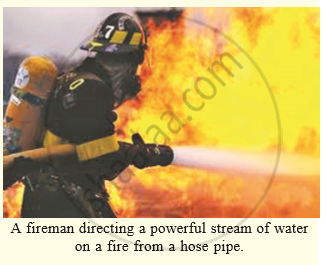
Explain why, when a fireman directs a powerful stream of water on a fire from a hose pipe, the hose pipe tends to go backward.
State the law of conservation of momentum.
Discuss the conservation of momentum in each of the following cases :
(i) a rocket taking off from ground.
(ii) flying of a jet aeroplane.
If a balloon filled with air and its mouth untied, is released with its mouth in the downward direction, it
moves upwards. Why ?
An unloaded truck weighing 2000 kg has a maximum acceleration of 0.5 m/s2. What is the maximum acceleration when it is carrying a load of 2000 kg ?
The rockets work on the principle of conservation of :
mass
energy
momentum
velocity
An object of mass 2 kg is sliding with a constant velocity of 4 m/s on a frictionless horizontal table. The force required to keep this object moving with the same velocity is :
32 N
0 N
2 N
8 N
The physical quantity which makes it easier to accelerate a small car than a large car is measured in the unit of :
m/s
kg
kg.m/s
kg.m/s2
According to the third law of motion, action and reaction :
always act on the same body but in opposite directions
always act on different bodies in opposite directions
have same magnitudes and directions
act on either body at normal to each other
The unit of measuring momentum of a moving body is :
m s−1
kg.ms−1
kg.m s−2
Nm2 kg−2
A boy of mass 50 kg standing on ground exerts a force of 500 N on the ground. The force exerted by the ground on the boy will be :
50 N
25000 N
10 N
500 N
A Honda City car, a Maruti Alto car, A Tata Nano car and a Mahindra Scorpio car, all are running at the same speed of 50 m/s under identical conditions. If all these cars are hit from behind with the same force and they continue to move forward, the maximum acceleration will be produced in :
The acceleration produced by a force of 5 N acting on a mass of 20 kg in m/s2 is :
4
100
0.25
2.5
Which of the following situations involves the Newton's second law of motion?
a force can stop a lighter vehicle as well as a heavier vehicle which are moving
a force can accelerate a lighter vehicle more easily than a heavier vehicle which are moving
a force exerted by a lighter vehicle on collision with a heavier vehicle results in both the vehicles coming to a standstill'
a force exerted by a escaping air from a balloon in the downward direction makes the balloon to go upwards
A fielder pulls his hands backwards after catching the cricket ball. This enables the fielder to :
exert larger force on the ball
reduce the force exerted by the ball
increase the rate of change of momentum
keep the ball in hands firmly
Why are car seat-belts designed to stretch some what in a collision ?
The troops (soldiers) equipped to be dropped by parachutes from an aircraft are called paratroopers. Why do paratroopers roll on landing ?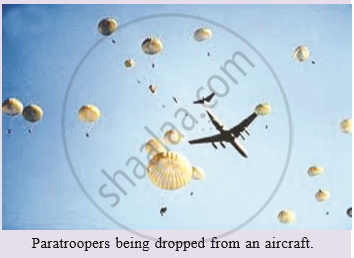
Why would an aircraft be unable to fly on the moon ?
Explain why it is possible for a small animal to fall from a considerable height without any injury being caused when it reaches the ground.
A boy of mass 50 kg running at 5 m/s jumps on to a 20 kg trolley travelling in the same direction at 1.5 m/s. What is their common velocity ?
A girl of mass 50 kg jumps out of a rowing boat of mass 300 kg on to the bank, with a horizontal velocity of 3 m/s. With what velocity does the boat begin to move backwards ?
A truck of mass 500 kg moving at 4 m/s collides with another truck of mass 1500 kg moving in the same direction at 2 m/s. What is their common velocity just after the collision if they move off together ?
A ball X of mass 1 kg travelling at 2 m/s has a head-on collision with an identical ball Y at rest. X stops and Y moves off. Calculate the velocity of Y after the collision.
A heavy car A of mass 2000 kg travelling at 10 m/s has a head-on collision with a sports car B of mass 500 kg. If both cars stop dead on colliding, what was the velocity of car B ?
A man wearing a bullet-proof vest stands still on roller skates. The total mass is 80 kg. A bullet of mass 20 grams is fired at 400 m/s. It is stopped by the vest and falls to the ground. What is then the velocity of the man?
Solutions for 2: Force and Laws of Motion
![Lakhmir Singh solutions for Physics (Science) [English] Class 9 ICSE chapter 2 - Force and Laws of Motion Lakhmir Singh solutions for Physics (Science) [English] Class 9 ICSE chapter 2 - Force and Laws of Motion - Shaalaa.com](/images/physics-science-english-class-9-icse_6:911f810b387d4e338a7779e8e703c1e7.jpg)
Lakhmir Singh solutions for Physics (Science) [English] Class 9 ICSE chapter 2 - Force and Laws of Motion
Shaalaa.com has the CBSE Mathematics Physics (Science) [English] Class 9 ICSE CBSE solutions in a manner that help students grasp basic concepts better and faster. The detailed, step-by-step solutions will help you understand the concepts better and clarify any confusion. Lakhmir Singh solutions for Mathematics Physics (Science) [English] Class 9 ICSE CBSE 2 (Force and Laws of Motion) include all questions with answers and detailed explanations. This will clear students' doubts about questions and improve their application skills while preparing for board exams.
Further, we at Shaalaa.com provide such solutions so students can prepare for written exams. Lakhmir Singh textbook solutions can be a core help for self-study and provide excellent self-help guidance for students.
Concepts covered in Physics (Science) [English] Class 9 ICSE chapter 2 Force and Laws of Motion are Force, Force - Push or Pull, Effect of Force, Types of Force: Contact Force, Types of Force: Non-Contact Force, Balanced and Unbalanced Forces, Newton's First Law of Motion, Inertia and Mass, Newton's Second Law of Motion, Newton's Third Law of Motion, Conservation of Momentum, Force and Laws of Motion (Numerical).
Using Lakhmir Singh Physics (Science) [English] Class 9 ICSE solutions Force and Laws of Motion exercise by students is an easy way to prepare for the exams, as they involve solutions arranged chapter-wise and also page-wise. The questions involved in Lakhmir Singh Solutions are essential questions that can be asked in the final exam. Maximum CBSE Physics (Science) [English] Class 9 ICSE students prefer Lakhmir Singh Textbook Solutions to score more in exams.
Get the free view of Chapter 2, Force and Laws of Motion Physics (Science) [English] Class 9 ICSE additional questions for Mathematics Physics (Science) [English] Class 9 ICSE CBSE, and you can use Shaalaa.com to keep it handy for your exam preparation.

